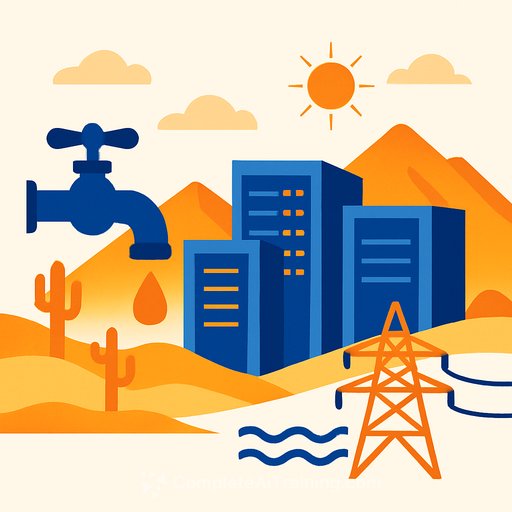Data Center Boom in Nevada's High Desert
East of Reno, Nevada, the golden foothills of the Virginia Range are transforming into a sprawling data center hub. The Tahoe Reno Industrial Center (TRI), larger than Detroit, is home to major players like Google, Switch, Microsoft, Apple, and others, all building or expanding massive facilities. This surge is driven by the intense demand for computing power to support artificial intelligence and cloud storage.
Microsoft has acquired over 225 acres within the center and additional land nearby, while Apple is expanding its nearby data center. OpenAI is also reportedly considering Nevada for its next facility. Switch’s campus alone could reach seven million square feet once complete, illustrating the scale of this development.
However, detailed information about the environmental impact, energy consumption, and water usage of these projects is scarce, as companies treat these as confidential. Estimates suggest that around 13 million square feet of data center space is currently under construction—equivalent to nearly five Empire State Buildings laid flat.
Energy Demand and Capacity
Public filings show that a dozen data center projects in the area have requested nearly six gigawatts of electricity over the next decade. This expansion would require increasing Nevada’s power sector capacity by roughly 40%, focused on a single industry. The added demand could translate into billions of gallons of water consumed annually, raising concerns about sustainability in one of the nation’s driest states.
Environmental Concerns
The concentration of energy- and water-intensive data centers in Nevada’s arid environment has sparked worry among water experts, environmental groups, and local communities. The Pyramid Lake Paiute Tribe, whose reservation includes Pyramid Lake at the end of the Truckee River, fears that increased water usage upstream will harm their water rights and the ecosystem.
Years of drought, groundwater depletion, and climate change-driven temperature increases compound these concerns. Kyle Roerink of the Great Basin Water Network highlights the risk of data centers disproportionately influencing water policy, urging careful management of these resources.
Luring Data Centers
The origins of the Tahoe Reno Industrial Center date back to the late 1990s when savvy real estate developers saw potential in the largely undeveloped area. Storey County adopted ordinances to fast-track commercial and industrial development, cutting permitting times significantly and attracting major tenants like Walmart and Tesla.
Today, quick approvals, inexpensive land, competitive electricity rates from NV Energy, favorable climate conditions, and tax incentives—including up to 75% abatements on property tax—make the area attractive for data center construction. The region’s low risk of natural disasters (aside from some seismic activity) adds to its appeal.
Economic Impact
While data centers require few permanent staff, construction jobs have surged, and the projects are diversifying the local economy beyond gaming and tourism. Tax revenues from Apple, Google, and Vantage alone are projected to approach half a billion dollars, even after generous abatements.
The Rain Shadow and Water Resources
Nevada’s dry climate results from the Sierra Nevada mountains blocking moisture from the Pacific Ocean, creating a rain shadow effect. The Truckee River, fed by Sierra snowmelt, is a critical water source flowing through Reno and Sparks to Pyramid Lake.
Nevada faces a long-term drought and over-appropriated groundwater basins. Climate change is expected to shorten the snow season, reduce reliable spring and summer runoff, and cause more erratic precipitation patterns. These trends necessitate smarter water storage, conservation, and planning, especially as industrial demands grow.
Water Use in Data Centers
Data centers require significant water for cooling. Advanced AI workloads generate extra heat, often cooled by liquid systems that rely heavily on water evaporated in cooling towers. A recent study estimated that Microsoft’s US data centers could have evaporated nearly 185,000 gallons of clean freshwater during training of the GPT-3 model alone.
Beyond direct water use, power plants supplying electricity to data centers also consume large volumes of water for their operations. Natural gas plants, which provide most of Nevada’s electricity, have high water withdrawal rates. Geothermal and solar power have different impacts, with solar requiring relatively little water.
Google is investing in geothermal projects that use brackish groundwater and claim lower water consumption compared to fossil fuel plants. NV Energy plans to expand solar power, battery storage, and natural gas peaking units, but details about water consumption and rate effects remain unclear.
Securing Water Supplies
The industrial center has developed a sophisticated water infrastructure, including on-site treatment facilities that recycle wastewater and deliver treated effluent via a 16-mile pipeline from the Truckee Meadows Water Authority. This system helps reduce reliance on groundwater, which is a critical environmental advantage.
Despite these efforts, data centers often require potable-quality water to prevent equipment issues. Water rights and allocations remain carefully managed: projects cannot proceed without demonstrated access to necessary water resources, enforced by the local general improvement district.
Water Rights and Local Impact
Water rights in the Truckee River basin have a complex legal history. The Pyramid Lake Paiute Tribe holds senior water rights, established through long-standing legal battles. The tribe depends on the lake and its native fish species for cultural and economic survival, making water conservation vital.
Chairman Steven Wadsworth emphasizes the lake’s importance as a life-sustaining resource deeply tied to tribal identity and heritage. Increased upstream water use by industrial developments raises concerns about reduced flows and ecosystem health.
Conclusion
The data center boom in Nevada's high desert presents substantial opportunities for economic growth and technological advancement. However, it also brings significant challenges related to energy consumption, water usage, and environmental stewardship. For real estate and construction professionals, understanding these factors is crucial when planning projects in the region.
Careful coordination among developers, utilities, regulators, and local communities will be essential to balance growth with sustainable resource management. As demand for data centers continues, keeping an eye on water availability and energy infrastructure will help ensure responsible development.
For those interested in the intersection of technology infrastructure and sustainability, exploring targeted education on AI and energy efficiency can be valuable. Resources like Complete AI Training's latest AI courses provide practical insights that can inform smarter planning in this sector.
Your membership also unlocks:






